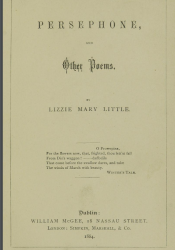William McGee, 18 Nassau Street, Dublin: The Publisher of 'Persephone, and Other Poems'
In 1884, William McGee published Lizzie Mary Little’s poetry collection Persephone, and Other Poems. McGee occupied a prominent position in the Dublin publishing business. His publishing house, located at 18 Nassau Street in Dublin, issued a wide range of literature, including poetry, histories, religious documents, and scientific texts. Interestingly, Lizzie Mary Little’s work, particularly her poem “Voices of the Age,” represents each of the aforementioned disciplines; McGee, therefore, was an appropriate choice of publisher. Her work’s promotion by such a prominent publisher also indicates the perceived merit of her work during the nineteenth century.
To read a related blog post, click here: http://blogs.baylor.edu/19crs/2020/01/15/victorian-voices…oices-of-the-age/
Coordinates
Longitude: -6.260309700000

